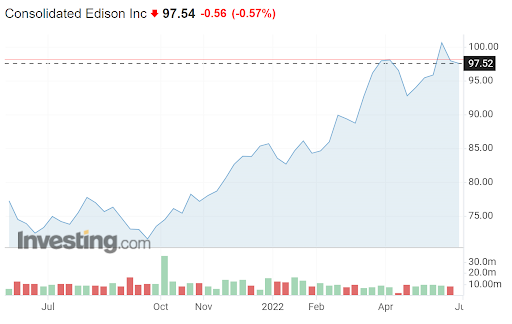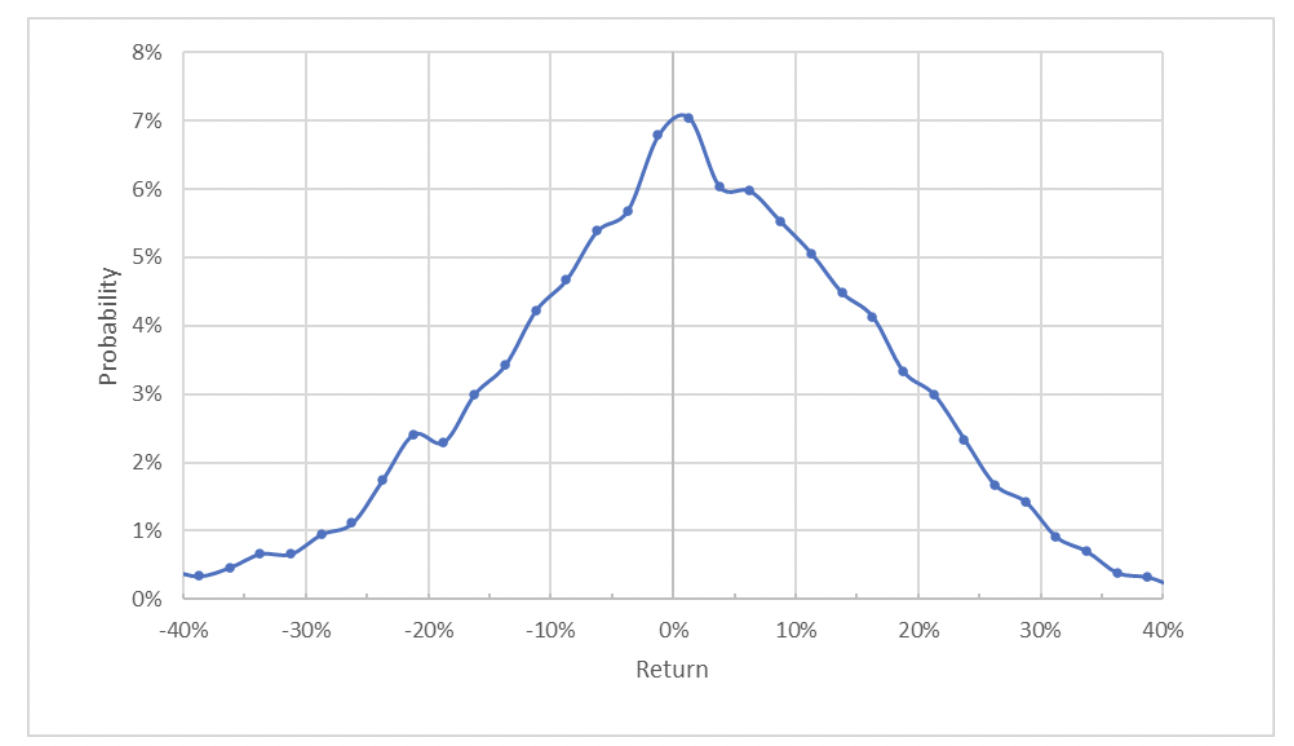- ED closed at an all-time high May 27
- The shares returned a total of 31% over the past 12 months
- Wall Street consensus rating is neutral to bearish
- Market-implied outlook to January 2023 is bullish
- For tools, data, and content to help you make better investing decisions, try InvestingPro+
Consolidated Edison (NYSE:ED) is one of the largest investor-owned energy companies in the U.S. Its shares closed at an all-time high of $100.58 on May 27. The trailing 12-month total return is 31.1%, as compared with 17.6% for the Utilities Select Sector SPDR® Fund (NYSE:XLU). Even with ED’s recent outsized gains, its trailing three-year return of 6.2% annualized is far below that of XLU, at 10.8% annualized.

Source: Investing.com
ED’s returns are even more notable given that earnings have been essentially flat for years. The consensus for EPS growth over the next three to five years is 3% per year. Earnings for Q4 of 2021, reported on Feb. 17, were 17.4% above the consensus expected value. These results certainly helped to boost the upward momentum. The Q1 2022 results reported May 5th slightly missed expectations.

Source: E-Trade
Green (red) values are the amount by which EPS beat (missed) consensus expected value.
With the substantial increase in the share price without gains in earnings, the P/E ratio has increased substantially. The current P/E of 22.7 is very high compared with historical values. As recently as September 2018, the P/E was 13.25. Valuations for large utilities are currently high, and ED’s valuation is certainly not an outlier.
Dividend income is often one of the major appeals of utility stocks, but ED’s price appreciation means that the current yield of 3.22% is quite low by historical standards. With the 10-year Treasury yield very close to 3%, risk-averse investors are increasingly likely to favor bonds for income.
Con Ed’s recent share price gains are partly attributable to the company’s increasing focus on clean energy. Investors have disproportionately bought up shares of utilities that emphasize clean energy, with NextEra Energy Inc (NYSE:NEE) being the extreme case (with a trailing 12-month P/E above 100). At the annual meeting in May, Con Ed CEO Timothy Cawley emphasized the company’s commitment to this space. Con Ed has published an extensive and detailed description of its efforts, ED’s clean energy commitment. The slide deck for the Q1 earnings call has a significant focus on clean energy, as well. ED, along with other utility stocks, has also gotten a boost from rising prices of oil and natural gas, which encourage consumers to favor increased electrification.
I last wrote about ED on Nov. 30, 2021, at which time I maintained a hold/neutral rating. At that time, the Wall Street consensus rating was bearish, with a consensus 12-month price target that was about 10% below the share price at that time. Along with looking at fundamentals and the analyst consensus, I also rely on the market-implied outlook, which represents the consensus view implied by the prices of options. At the end of November, the market-implied outlook to mid-January of 2022 was bullish and the outlook to January 2023 was neutral to slightly bullish. With the disagreement between the bearish Wall Street consensus outlook and the more bullish market-implied outlook, I compromised with a neutral overall rating. The shares have returned a total of 27.9% since the close on Nov. 30.
For readers who are unfamiliar with the market-implied outlook, a brief explanation is needed. The price of an option on a stock is largely determined by the market’s consensus estimate of the probability that the stock price will rise above (call option) or fall below (put option) a specific level (the option strike price) between now and when the option expires. By analyzing the prices of call and put options at a range of strike prices, all with the same expiration date, it is possible to calculate a probable price forecast that reconciles the option prices. This is the market-implied outlook. For a deeper explanation and background, I recommend this monograph published by the CFA Institute.
I have calculated the market-implied outlook for ED to early 2023 and compared it with the current Wall Street consensus outlook in revisiting my rating.
Wall Street Consensus Outlook For ED
E-Trade calculates the Wall Street consensus outlook by combining the views of 10 ranked analysts who have published ratings and price targets for ED over the past three months. The consensus rating is bearish, as it has been for all of the past year. The consensus 12-month price target is 9.7% below the current share price. Of the 10 analysts, six assign a sell rating, three have a hold rating and one gives ED a buy rating.

Source: E-Trade
Investing.com calculates the Wall Street consensus outlook for ED using ratings and price targets from 16 analysts. The consensus rating is neutral, while the consensus 12-month price target is 9.7% below the current share price.

Source: Investing.com
The Wall Street consensus price target at the end of November indicated that the shares were overvalued by about 10%, very similar to the current results. The 27.9% total returns for ED since Nov. 30 is quite a contrast to the consensus price target at that time. I believe that what the analysts did not anticipate was the price premium that the market would support as the company has publicized its growing commitment to clean energy.
Market-Implied Outlook For ED
I have calculated the market-implied outlook for ED for the 7.4-month period from today until Jan. 20, 2023, using the prices of call and put options that expire on this date. I selected this specific expiration date to provide a view through the end of the year and because the options expiring in January tend to be some of the most actively traded. In addition, my analysis in November had the market-implied outlook calculated using the January 2023 options, providing a point of comparison.
The standard presentation of the market-implied outlook is a probability distribution of price return, with probability on the vertical axis and return on the horizontal.

Source: Author’s calculations using options quotes from E-Trade
The market-implied outlook is generally symmetric, with the peak in probability close to zero return (about +1%). The expected volatility calculated from this outlook is 23% (annualized), which is quite low for a large-cap stock, consistent with what one expects to see for a utility. The outlook is also somewhat negatively skewed, a bullish indicator.
To make it easier to directly compare the relative probabilities of positive and negative returns, I rotate the negative return side of the distribution about the vertical axis (see chart below).

Source: Author’s calculations using options quotes from E-Trade
The negative return side of the distribution has been rotated about the vertical axis.
This view shows that the probability of positive returns is consistently higher than the probabilities of same-sized negative returns, across a wide range of the most probable outcomes (the solid blue line is significantly above the dashed red line over much of the left three-quarters of the chart above). This is a bullish outlook to Jan. 20, 2023.
Theory indicates that the market-implied outlook is expected to have a negative bias because risk-averse investors tend to pay more than fair value for downside protection, although there is no way to measure whether this effect is present. Considering this potential bias suggests an even more bullish interpretation than is evident from the raw probabilities.
At the end of November 2021, the market-implied outlook to Jan. 20, 2023, was predominantly neutral, with a slight bullish tilt, although the view to January 2022 was quite bullish.
Summary
Shares of Con Ed have substantially outpaced the broader market and utilities indexes over the past year. Earnings have been solid, but not especially notable, and the valuation is quite high. The Wall Street consensus rating for ED is neutral to bearish, depending on the source of the consensus calculation, and the consensus 12-month price target is about 10% below the current share price. The market-implied outlook to mid-January 2023 is bullish, with moderate volatility. My hypothesis is that the market is supporting a price premium for ED because of the company’s growing emphasis on clean energy, while the analyst estimates are based on expected earnings growth over the next several years. With the ongoing disagreement between the bearish analyst consensus outlook and the bullish market-implied outlook, along with the fairly high valuation, I am maintaining my neutral/hold rating for ED.
***
Interested in finding your next great idea? InvestingPro+ gives you the chance to screen through 135K+ stocks to find the fastest growing or most undervalued stocks in the world, with professional data, tools, and insights. Learn More »
Which stock should you buy in your very next trade?
With valuations skyrocketing in 2024, many investors are uneasy putting more money into stocks. Unsure where to invest next? Get access to our proven portfolios and discover high-potential opportunities.
In 2024 alone, ProPicks AI identified 2 stocks that surged over 150%, 4 additional stocks that leaped over 30%, and 3 more that climbed over 25%. That's an impressive track record.
With portfolios tailored for Dow stocks, S&P stocks, Tech stocks, and Mid Cap stocks, you can explore various wealth-building strategies.
